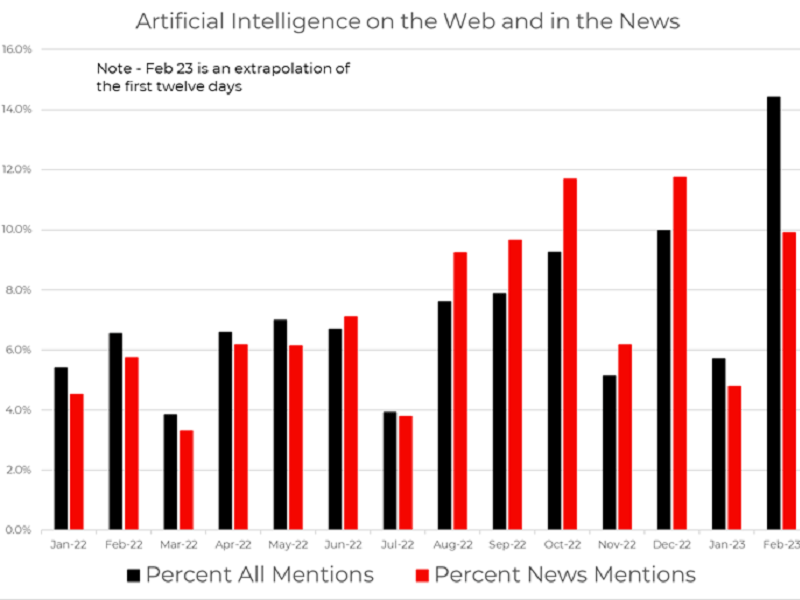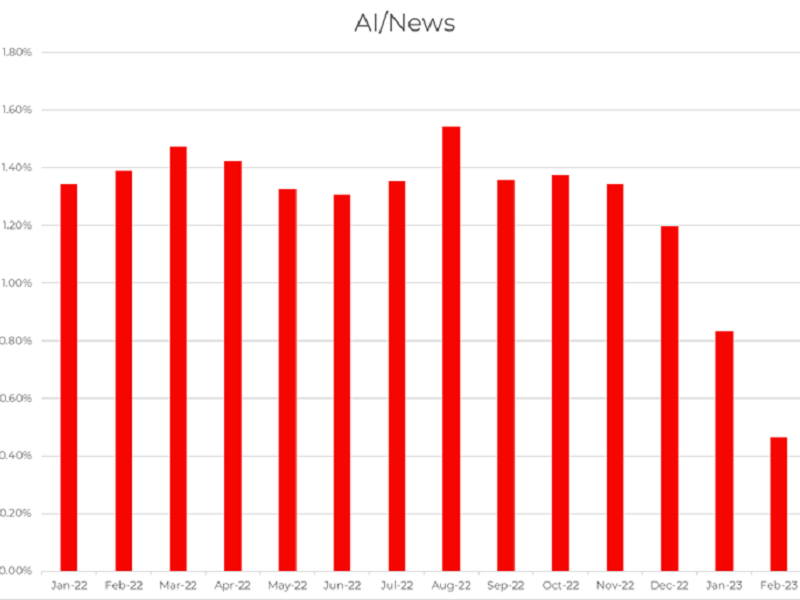OpenAI’s launch of ChatGPT in November 2022 has spurred a cascade of articles and commentary on artificial intelligence. The discussion, however, reveals how much artificial intelligence is already deployed.
Artificial intelligence (AI) is one of those technologies with a long history of disappointment. Dating back to Alan Turing at the start of the theory of computing (or, more technically, computability), interest reached a high point with the development of “expert systems” in the early 1980s. These systems created great excitement about the possibilities of AI, but delivery was disappointing. As a result, histories of AI (see note) refer to the following period as the “AI Winter”.
Both major parties took policies supporting AI to the last federal election. A survey of voters, even knowledgeable ones, on policy commitments made for that election is unlikely to turn up AI as an important policy position. On the other hand, ChatGPT has been a big story for some of us, with suggestions that it can take over many jobs and concerns about the integrity of academic credentialing.
To test the theory that there is now a lot more conversation about AI, Google’s ability to search by time and give a count of responses is useful. The chart below shows the percentage of results each month for the search “artificial intelligence site:.au” against the total results from 1 January 2022 to 12 February 2023, searching All and just News.

The chart supports the proposition that AI has been in the news and is generally discussed more. However, we need to control for how many total resources Google has searched over. Dividing the News hits for artificial intelligence by the result from just searching “site:.au” provides a different picture.

Despite this evidence that increased discussion about AI is selective hearing, the whole ChatGPT has reminded us that AI is everywhere. The language processing inherent in OpenAI’s ChatGPT and related Whisper projects is at the core of many virtual agents sitting behind numerous websites. They also power the voice assistants in Siri, Alexa and Google to varying degrees.
The range of AI apps that individuals can access is growing, as YouTube videos demonstrating five, 14 and 44 tools show. However, ChatGPT probably got the most interest because it is the easiest to use – you can start it off with any question.
For example, the text at the end of this article was written by ChatGPT in response to “Write a 700-word newspaper column on AI in innovation mentioning ChatGPT” The resulting text was then reviewed using Grammarly, which made several “plain English” suggestions, inserted punctuation and converted it to Australian English.
The column ChatGPT wrote is repetitive and uses the kind of managerial sludge that Don Watson railed against in Death Sentence. Noting that enhances Watson’s point about business and policy writing being dominated by very poor style. This reflects the simple fact that ChatGPT has been trained on the widest source of public text.
A recent tweet containing the results of a request for a 300-word strategy for a major research University also revealed this simple fact. The resulting strategy could easily be mistaken for an actual one because of the sludge. It suggests a new KPI for strategy documents; they have to be written so that it is clear they weren’t written by ChatGPT.
A similar observation can be made about David Astle’s discovery that ChatGPT found it hard to write a cryptic crossword clue for “marmalade”. An AI tool trained on a database of cryptic clues and their answers could be expected to have done better. Similarly, training the tool on good policy or strategy writing (if any exists) would help.
For people worried about whether a text was or wasn’t written by ChatGPT, I asked Chat GPT if the words below had been written by ChatGPT. It replied, ” Yes, the text was generated by me”.
But back to the beginning. AI really is everywhere. The question is how to make a good AI policy. One place to start is by addressing the stupid migration processes faced by our brightest international PhD students. For example, the international students I know at the University of Wollongong working on AI can’t qualify for permanent residency unless they have worked here for three years post-degree. Yet, employers are reluctant to employ anyone without permanent residency.
The Technology Council of Australia needs to better educate its members on migration pathways and the value of hiring these graduates. The Government equally should consider a category for graduates for whom permanent residency can be automatic. These students have options in other countries that will grant immediate permanent residency.
Overall, we need AI policy, and indeed all innovation policy, to read like it wasn’t written by an AI engine, no matter how well trained.
Note: For histories of AI see:
Nilsson, Nils J.. The Quest for Artificial Intelligence (p. 342). Cambridge University Press.
McCorduck, Pamela; Cfe, Cli. Machines Who Think (p. 442). CRC Press.
********************************
AI in innovation – a column by ChatGPT
Artificial intelligence (AI) has revolutionised the way we innovate, creating new opportunities and driving growth across various industries. AI-powered solutions have transformed the way businesses operate and have revolutionised the way we live our daily lives. One of the key players in the AI innovation revolution is OpenAI’s ChatGPT.
ChatGPT is a cutting-edge AI language model that uses machine learning algorithms to generate human-like responses. With its ability to process and understand natural language, ChatGPT has been integrated into various applications, from customer service Chatbots to language translation software.
One of the most notable examples of AI innovation in business is how ChatGPT has transformed customer service. Customer service is one of the most critical aspects of any business. AI-powered Chatbots powered by ChatGPT can handle a wide range of customer queries, from simple questions to more complex issues, 24/7. This has allowed companies to provide faster and more efficient customer service, improving customer satisfaction and increasing loyalty.
Another area where AI and ChatGPT, in particular, have had a significant impact is in the development of new products and services. AI-powered solutions are helping businesses to quickly analyse large amounts of data and identify new opportunities for innovation. For example, ChatGPT can be used to analyse customer feedback and identify patterns in customer behaviour, allowing businesses to develop new products and services that better meet the needs and preferences of their customers.
In addition, AI is also driving innovation in the healthcare industry. AI-powered solutions, such as ChatGPT, are helping healthcare professionals to diagnose and treat patients more effectively by analysing vast amounts of medical data. For example, ChatGPT can be trained on medical records to help identify patterns and predict potential health risks, enabling healthcare professionals to provide proactive and personalised patient care.
AI is also having a major impact on the financial services industry. AI-powered solutions, such as ChatGPT, are helping financial institutions to make more informed investment decisions by analysing vast amounts of financial data. ChatGPT can also develop personalised investment strategies for individual customers, helping them reach their financial goals more effectively.
Finally, AI is also having a major impact on the education sector. AI-powered solutions, such as ChatGPT, are helping educators to provide more personalised and effective learning experiences for students. For example, ChatGPT can be used to develop adaptive learning systems that adjust the content and pace of learning to each student’s individual needs and abilities. This can revolutionise the way students learn and improve educational outcomes for students of all ages.
In conclusion, AI and specifically ChatGPT significantly impact innovation across a range of industries. AI-powered solutions are helping businesses to improve customer service, develop new products and services, and drive innovation in healthcare, finance, education, and much more. As AI continues to evolve and improve, we will likely see even more exciting and innovative applications in the years to come.
Do you know more? Contact James Riley via Email.
